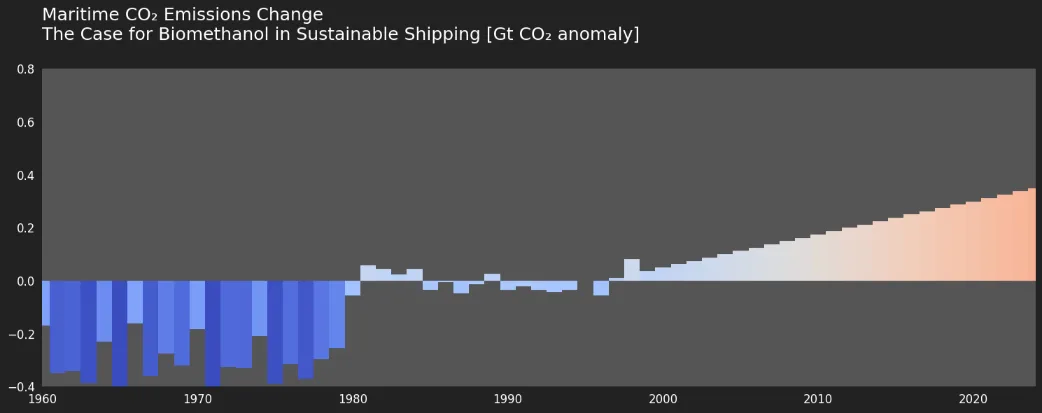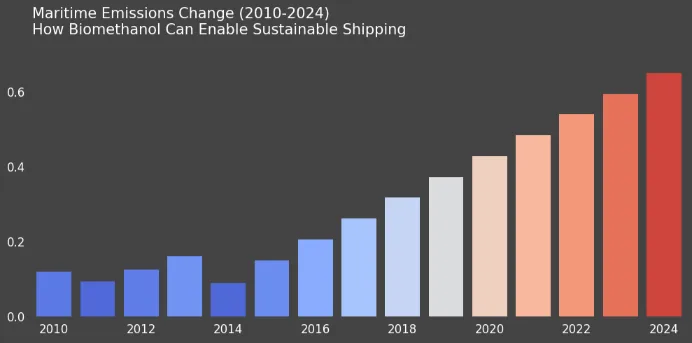
How Biomethanol Is Paving The Way For Sustainable Maritime Transport
The maritime industry is changing as it faces increasing pressure to lessen its environmental impact. The International Maritime Organization (IMO) has set ambitious goals to reduce carbon emissions by 40% by 2030 and by 70% by 2050 compared to 2008 levels. As a result, the search for sustainable fuels has intensified. Among the promising options, biomethanol stands out as a versatile, scalable, and cleaner alternative to traditional marine fuels.
This blog looks at how biomethanol is transforming maritime transport, its environmental and operational benefits, the challenges ahead, and why it is likely to become a key component of sustainable shipping.
What is Biomethanol?
Biomethanol is renewable methanol made from sustainable biomass sources such as forestry and agricultural residues, municipal solid waste, biogas, and industrial by-products like black liquor from the pulp and paper industry. Unlike fossil fuel-derived methanol, biomethanol has a much lower carbon footprint, often reducing greenhouse gas emissions by up to 95% over its lifetime.
It can be used directly as a marine fuel or as a feedstock to create other renewable fuels like dimethyl ether (DME) and biodiesel. Its liquid state at room temperature makes it easier to store and handle compared to gases like hydrogen or ammonia.
The Urgency for Sustainable Maritime Fuels
Shipping is responsible for nearly 3% of global greenhouse gas emissions, with heavy fuel oil (HFO) traditionally powering most vessels. HFO is highly polluting and emits sulfur oxides (SOx), nitrogen oxides (NOx), particulate matter, and CO₂. To meet the IMO’s decarbonization goals, the industry needs to move away from fossil fuels to low- or zero-carbon options.
Biomethanol is gaining popularity because it provides a practical way to reduce emissions without a complete overhaul of existing ship engines and infrastructure.
Advantages of Biomethanol in Maritime Transport
1. Significant Carbon Emission Reductions
Biomethanol cuts lifecycle CO₂ emissions by up to 95% compared to conventional marine fuels. This makes it a strong option for meeting IMO and EU emissions targets, including the EU’s Fit for 55 package and FuelEU Maritime regulation, which requires gradual emissions reductions for ships arriving at EU ports.
2. Compatibility with Existing and New Engines
Many shipbuilders now provide dual-fuel engines that can run on both methanol and traditional fuels. This flexibility allows operators to transition gradually, reducing operational risks and costs. Retrofitting existing vessels is also possible, which speeds up adoption.
3. Easier Storage and Handling
Biomethanol is liquid at normal conditions and can be stored in standard tanks without the need for cryogenic or high-pressure systems. This reduces infrastructure costs and simplifies bunkering logistics at ports.
4. Feedstock Diversity and Circular Economy Alignment
Biomethanol can come from various sustainable sources, including forestry residues, agricultural waste, and municipal solid waste. This decentralized production can support local economies and lessen dependence on fossil fuel imports.
5. Regulatory and Market Momentum
Governments around the world are encouraging biomethanol use with subsidies, emissions trading schemes, and mandates. Early adopters like Maersk and Norway’s NCL Vestland vessel are already operating bio-methanol-powered ships, gaining operational experience and credibility in the market.
How Biomethanol Production Works for Maritime Fuel
Producing biomethanol involves gasifying biomass to create synthesis gas (a mix of CO, H₂, and CO₂), which is then converted into methanol. This process can incorporate carbon capture and utilization (CCU) technologies to further lower emissions.
The resulting biomethanol fuel meets strict marine fuel standards and can be blended or used directly in methanol-capable engines.
Global Developments and Industry Adoption
- Norway: In April 2025, Norway launched the NCL Vestland, its first biomethanol-powered feeder ship, marking a significant step in sustainable shipping.
- Maersk: The shipping giant has expanded its fleet of methanol-enabled vessels and secured long-term biomethanol supply agreements, showing strong industry commitment.
- China: New biomethanol plants are being built to supply the maritime sector, driven by increasing demand in Asia.
- Europe: The EU’s FuelEU Maritime regulation is promoting rapid regulatory adoption and infrastructure development for biomethanol bunkering.
Challenges Facing Biomethanol Adoption in Shipping
Production Scale and Cost
Current biomethanol production capacity is smaller than the scale required for global shipping fuel needs. Production costs remain higher than those of fossil marine fuels, which calls for ongoing technological improvements and economies of scale.
Infrastructure Development
Expanding bunkering facilities and supply chains is essential. Ports globally must invest in methanol storage and fueling infrastructure to meet growing demand.
Policy and Market Uncertainty
While regulatory frameworks are improving, inconsistent policies across regions can create market uncertainty, potentially hindering investment and adoption.
The Future Outlook: Biomethanol as a Maritime Fuel of Choice
The biomethanol market is expected to grow rapidly, reaching USD 2.1 billion by 2032 with a CAGR of 44.5% from 2025 to 2032. This growth is driven by environmental regulations, sustainability goals, technological advancements, and circular economy initiatives.
As the maritime industry works to reduce carbon emissions, biomethanol provides a scalable, flexible, and cleaner fuel option that aligns with global climate objectives. Early adopters are gaining advantages through operational experience and compliance with regulations, positioning biomethanol as a vital part of sustainable maritime transport.
Conclusion
Biomethanol is more than just an alternative marine fuel—it is changing the future of shipping. Its environmental benefits, compatibility with existing engines, and fit with circular economy principles make it a practical and effective tool for the maritime sector’s journey toward decarbonization.
With ongoing investment, policy support, and infrastructure development, biomethanol is ready to lead the way for sustainable, low-carbon maritime transport, helping the world’s shipping fleets operate cleaner and greener.
Further Reading on Biomethanol in Maritime Transport
- Biomethanol and its role in advancing sustainable shipping
- Zero Carbon Shipping: Bio-methanol as marine fuel
- Bio-methanol gains momentum as maritime shipping embraces cleaner fuels
- Methanol Institute: Methanol as marine fuel
- DNV report on alternative fuels for shipping
- Transport & Environment: Green methanol as shipping fuel

Related Reads on Biomethanol:
Explore how agricultural waste is being turned into clean fuel through innovative biomethanol production.
Discover how small businesses are saving money and going green with biomethanol solutions.

